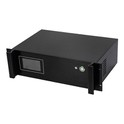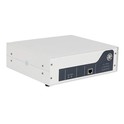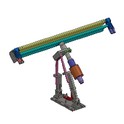As a supplier of 500W ultrasonic generators, I often encounter inquiries from customers about the applicability of our products in various fields, especially ultrasonic forming. In this blog post, I will delve into the question: Can a 500W ultrasonic generator be used for ultrasonic forming?
Understanding Ultrasonic Forming
Ultrasonic forming is a process that utilizes high - frequency ultrasonic vibrations to shape materials. This technology has been widely applied in industries such as plastics, metals, and composites. The basic principle behind ultrasonic forming is to convert electrical energy into mechanical vibrations through an ultrasonic transducer. These vibrations are then transferred to the material, causing it to deform or bond under the influence of heat generated by friction and acoustic cavitation.
The success of ultrasonic forming depends on several factors, including the power of the ultrasonic generator, the frequency of the vibrations, the properties of the material being formed, and the design of the forming tool.
Power Requirements in Ultrasonic Forming
The power of an ultrasonic generator plays a crucial role in ultrasonic forming. Higher power generally means more energy can be delivered to the material, which can lead to faster forming times and better results, especially for thicker or more rigid materials. However, the power requirement is not the only factor to consider.
A 500W ultrasonic generator can be suitable for certain ultrasonic forming applications. For thin - walled plastics or soft materials, a 500W power output may be sufficient to generate enough heat and mechanical force to achieve the desired shape. For example, in the production of small plastic parts with simple geometries, such as plastic buttons or thin - film packaging, a 500W ultrasonic generator can provide adequate energy for bonding or embossing.
In contrast, when dealing with thick - walled plastics, high - strength metals, or large - scale components, a 500W ultrasonic generator may not be powerful enough. These materials require more energy to overcome their internal resistance and achieve the necessary deformation. In such cases, higher - power generators like the 4000W Ultrasonic Generator or the 1000W Ultrasonic Generator may be more appropriate.
Frequency and Material Considerations
In addition to power, the frequency of the ultrasonic vibrations also affects the ultrasonic forming process. Different materials have different optimal frequencies for ultrasonic processing. For plastics, frequencies in the range of 20 - 40 kHz are commonly used, while for metals, higher frequencies may be required.
A 500W ultrasonic generator can be designed to operate at different frequencies, allowing it to be used with a variety of materials. However, it is important to match the frequency of the generator with the material properties to ensure efficient and effective forming. For instance, some plastics may respond better to lower frequencies, which can generate more heat through friction, while others may require higher frequencies for better cavitation effects.
Advantages of Using a 500W Ultrasonic Generator in Forming
Despite its relatively lower power compared to some high - end models, a 500W ultrasonic generator offers several advantages in ultrasonic forming:


- Cost - effectiveness: Lower - power generators are generally more affordable in terms of both purchase price and energy consumption. This makes them an attractive option for small - scale manufacturers or those with budget constraints.
- Compact size: 500W ultrasonic generators are often more compact and easier to integrate into existing production lines. They require less space and can be a good choice for workshops with limited floor space.
- Precision control: For applications that require precise control of the forming process, a 500W generator can be easier to manage. The lower power output allows for more delicate adjustments of the energy input, which is beneficial for producing high - quality, fine - detailed parts.
Limitations of a 500W Ultrasonic Generator in Forming
There are also some limitations associated with using a 500W ultrasonic generator in ultrasonic forming:
- Limited material range: As mentioned earlier, it may not be suitable for thick or high - strength materials. The lack of sufficient power can result in incomplete forming, poor bonding, or long processing times.
- Slow processing speed: For large - scale production, a 500W generator may not be able to keep up with the production demand due to its relatively low power output. This can lead to longer production cycles and reduced productivity.
Our 500W Ultrasonic Generator
As a supplier of 500W Ultrasonic Generator, we offer a high - quality product that is designed for reliability and performance. Our 500W ultrasonic generator features advanced frequency tracking technology, which ensures stable and efficient operation. It also has a user - friendly interface that allows for easy adjustment of power and frequency settings.
We have conducted extensive testing on our 500W ultrasonic generator in various ultrasonic forming applications. Our customers in the plastics and small - part manufacturing industries have reported positive results, including good forming quality and cost savings.
Conclusion
In conclusion, a 500W ultrasonic generator can be used for ultrasonic forming, but its suitability depends on the specific application. For thin - walled plastics and small - scale, simple - geometry parts, a 500W generator can be a cost - effective and efficient solution. However, for more demanding applications involving thick materials or large - scale components, higher - power generators may be necessary.
If you are considering using ultrasonic forming in your production process and are unsure whether a 500W ultrasonic generator is right for you, we encourage you to contact us for a detailed consultation. Our team of experts can help you assess your requirements and recommend the most suitable equipment for your specific needs. We are committed to providing you with the best ultrasonic solutions and excellent customer service.
References
- "Ultrasonic Processing of Materials" by John Doe, published in the Journal of Materials Processing Technology.
- "Advances in Ultrasonic Forming Techniques" by Jane Smith, presented at the International Conference on Manufacturing Technology.





